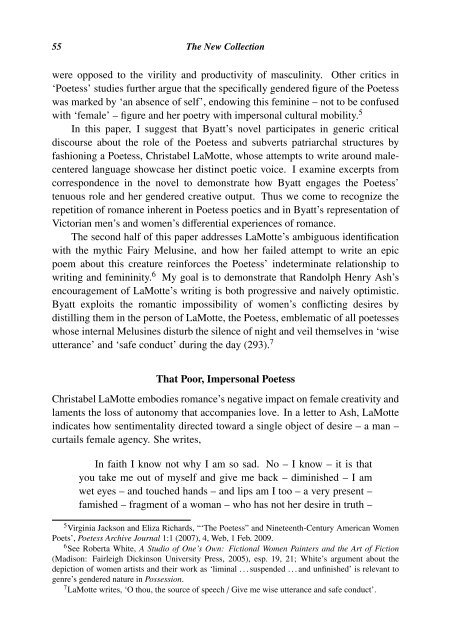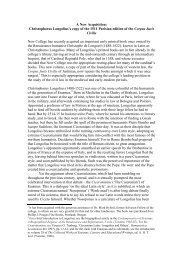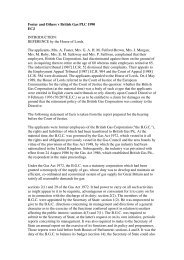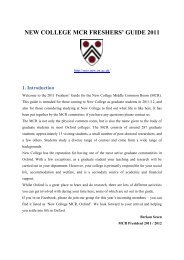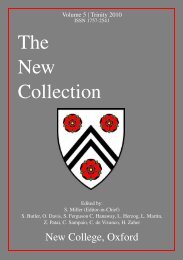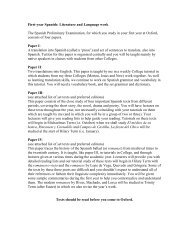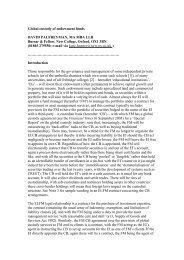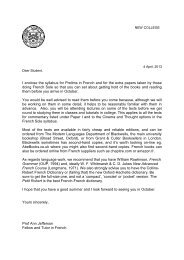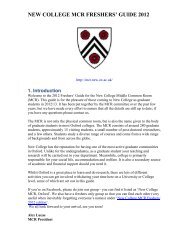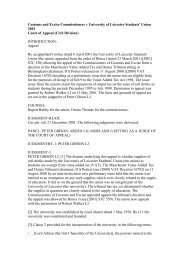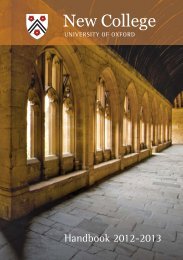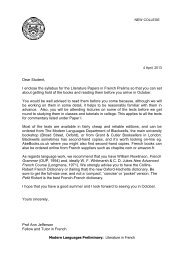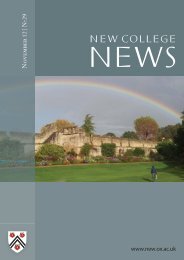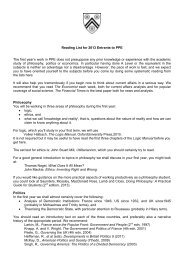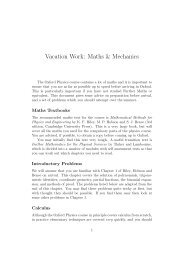Here - New College MCR - University of Oxford
Here - New College MCR - University of Oxford
Here - New College MCR - University of Oxford
Create successful ePaper yourself
Turn your PDF publications into a flip-book with our unique Google optimized e-Paper software.
55 The <strong>New</strong> Collection<br />
were opposed to the virility and productivity <strong>of</strong> masculinity. Other critics in<br />
‘Poetess’ studies further argue that the specifically gendered figure <strong>of</strong> the Poetess<br />
was marked by ‘an absence <strong>of</strong> self’, endowing this feminine – not to be confused<br />
with ‘female’ – figure and her poetry with impersonal cultural mobility. 5<br />
In this paper, I suggest that Byatt’s novel participates in generic critical<br />
discourse about the role <strong>of</strong> the Poetess and subverts patriarchal structures by<br />
fashioning a Poetess, Christabel LaMotte, whose attempts to write around malecentered<br />
language showcase her distinct poetic voice. I examine excerpts from<br />
correspondence in the novel to demonstrate how Byatt engages the Poetess’<br />
tenuous role and her gendered creative output. Thus we come to recognize the<br />
repetition <strong>of</strong> romance inherent in Poetess poetics and in Byatt’s representation <strong>of</strong><br />
Victorian men’s and women’s differential experiences <strong>of</strong> romance.<br />
The second half <strong>of</strong> this paper addresses LaMotte’s ambiguous identification<br />
with the mythic Fairy Melusine, and how her failed attempt to write an epic<br />
poem about this creature reinforces the Poetess’ indeterminate relationship to<br />
writing and femininity. 6 My goal is to demonstrate that Randolph Henry Ash’s<br />
encouragement <strong>of</strong> LaMotte’s writing is both progressive and naively optimistic.<br />
Byatt exploits the romantic impossibility <strong>of</strong> women’s conflicting desires by<br />
distilling them in the person <strong>of</strong> LaMotte, the Poetess, emblematic <strong>of</strong> all poetesses<br />
whose internal Melusines disturb the silence <strong>of</strong> night and veil themselves in ‘wise<br />
utterance’ and ‘safe conduct’ during the day (293). 7<br />
That Poor, Impersonal Poetess<br />
Christabel LaMotte embodies romance’s negative impact on female creativity and<br />
laments the loss <strong>of</strong> autonomy that accompanies love. In a letter to Ash, LaMotte<br />
indicates how sentimentality directed toward a single object <strong>of</strong> desire – a man –<br />
curtails female agency. She writes,<br />
In faith I know not why I am so sad. No – I know – it is that<br />
you take me out <strong>of</strong> myself and give me back – diminished – I am<br />
wet eyes – and touched hands – and lips am I too – a very present –<br />
famished – fragment <strong>of</strong> a woman – who has not her desire in truth –<br />
5 Virginia Jackson and Eliza Richards, “‘The Poetess” and Nineteenth-Century American Women<br />
Poets’, Poetess Archive Journal 1:1 (2007), 4, Web, 1 Feb. 2009.<br />
6 See Roberta White, A Studio <strong>of</strong> One’s Own: Fictional Women Painters and the Art <strong>of</strong> Fiction<br />
(Madison: Fairleigh Dickinson <strong>University</strong> Press, 2005), esp. 19, 21; White’s argument about the<br />
depiction <strong>of</strong> women artists and their work as ‘liminal . . . suspended . . . and unfinished’ is relevant to<br />
genre’s gendered nature in Possession.<br />
7 LaMotte writes, ‘O thou, the source <strong>of</strong> speech / Give me wise utterance and safe conduct’.


